Go
Deep
(Rockfishing from a Private Boater's Perspective)
by
Ted Cernak
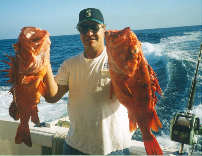 Shallow water rockfishing is pretty poor
below the Channel Islands. Sure, there are places along the south coast where you can drop
down 250-350 feet and pickup some fair sized fish, but the sport boats hammer the known
spots all winter long and you're lucky if you catch anything over 5-6 pounds. To
consistently catch fish in the 10-20+ pound range, you need to go deep…I’m
talking 350 to 900+ feet. Fishing these depths requires some specialized tackle and
techniques, unless of course, you enjoy pain. Shallow water rockfishing is pretty poor
below the Channel Islands. Sure, there are places along the south coast where you can drop
down 250-350 feet and pickup some fair sized fish, but the sport boats hammer the known
spots all winter long and you're lucky if you catch anything over 5-6 pounds. To
consistently catch fish in the 10-20+ pound range, you need to go deep…I’m
talking 350 to 900+ feet. Fishing these depths requires some specialized tackle and
techniques, unless of course, you enjoy pain.
Rods & Reels
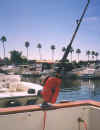 If you’re anything like me, your tackle
has to do double duty. I use a 7-foot, 50 Pound Class, all roller, trolling rod for
rockfishing. I couple this with a 6/0 Penn Senator, 80 pound, Dacron line and an
Elec-Tra-Mate matched to the reel. If you’re anything like me, your tackle
has to do double duty. I use a 7-foot, 50 Pound Class, all roller, trolling rod for
rockfishing. I couple this with a 6/0 Penn Senator, 80 pound, Dacron line and an
Elec-Tra-Mate matched to the reel.
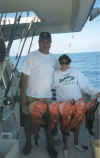
I can hear some of you now…"Electric
reels, that’s sporting!" Well that’s what I thought at first, but it’s
just not practical to fish deep with a five-pound lead using a conventional reel. Rockfish
are not exactly known for their fighting ability, and the real skill involved here, is in
the hunt and your boat handling. Besides, fishing is supposed to be fun! (Ted is pictured with his wife after a trip out to a bank near
San Clemente)
Terminal Tackle
I tie all my own ganions. In the past, I’ve used an 8-foot
long, 7-hook ganion. Under the new regulations I’ve opted for a 6 1/2-foot ganion
with a 125 pound main line, barrel swivels placed between beads and crimp sleeves spaced
18 inches apart with a 10/0 circle hook tied exactly 6 inches from the opposite end of the
swivels on the main line using 100 pound mono. To finish things off, I attach a barrel
swivel at each end of the main line with a crimp sleeve.
Your ganions are the business end of things and it’s
important that they be tied correctly. If the connection from the hook to the main line is
too long or if you use a lighter mono, you’ll spend the day untangling your rig after
each drop. If you use a cheap store bought ganion without swivels on the mainline,
you’ll spin off a lot of fish on the way up and/or twist your rig till it’s no
longer useable.
 Over the years, my friends and I have
experimented with a lot of different set-ups and that includes sinkers. We’ve painted
them orange thinking they might look like another rockfish and attract the real thing, but
color doesn’t seem to matter. We’ve even made sinkers out of scrap rebar that
we’ve picked up at construction sights. A 16-inch piece of 1 ½ inch diameter rebar
weighs about 5 pounds, and while color doesn’t make much of a difference, the paint
cuts down on rust stains. The rebar does however, make a sharper sound banging against the
rocks than a lead sinker and will get you more fish. Over the years, my friends and I have
experimented with a lot of different set-ups and that includes sinkers. We’ve painted
them orange thinking they might look like another rockfish and attract the real thing, but
color doesn’t seem to matter. We’ve even made sinkers out of scrap rebar that
we’ve picked up at construction sights. A 16-inch piece of 1 ½ inch diameter rebar
weighs about 5 pounds, and while color doesn’t make much of a difference, the paint
cuts down on rust stains. The rebar does however, make a sharper sound banging against the
rocks than a lead sinker and will get you more fish.
Whatever type of sinker you decide on, use a weight that gets
you to the bottom with a minimum amount of scope in your line. No angles, no tangles! Tie
it a foot below the bottom swivel using 40 or 50 pound mono and a not-so-good knot. In the
event you get hung-up in the rocks, your line will break between the bottom swivel and
sinker saving your ganion and any fish you’ve hooked!
Bait
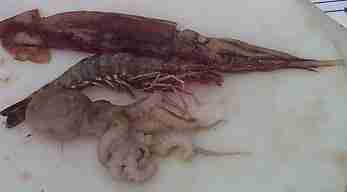 As is the case with many of the fish off our coast, live squid is the bait
of choice for rockfish. However, live squid are hard to come by and when you can find
them, there’s a price to pay. In lieu of live squid, frozen is your next best bet.
Every year, when the squid are thick and market prices are low, I head to the State Fish
Company at the commercial docks in San Pedro and pick up a couple of hundred pounds of
frozen squid. You’ll pay anywhere from $.35 - $.50 per pound for a 5 pound box which
is a heck of a lot better than the $2.00+ per pound the tackle shops and landings get.
Belly strips are another good bet…particularly for lingcod! As is the case with many of the fish off our coast, live squid is the bait
of choice for rockfish. However, live squid are hard to come by and when you can find
them, there’s a price to pay. In lieu of live squid, frozen is your next best bet.
Every year, when the squid are thick and market prices are low, I head to the State Fish
Company at the commercial docks in San Pedro and pick up a couple of hundred pounds of
frozen squid. You’ll pay anywhere from $.35 - $.50 per pound for a 5 pound box which
is a heck of a lot better than the $2.00+ per pound the tackle shops and landings get.
Belly strips are another good bet…particularly for lingcod!
Dropping Down
 When you’re on a tuna trip and
there’s a jig strike, the first guy in the water with a live bait usually gets bit.
It’s no different here. When the skipper says drop ‘em, the first guy down
almost always gets the most fish! When you hit bottom, reel-up a foot or so, this will cut
down on hang-ups. You walk a fine line here, in that you need to stay close to the bottom,
but don’t want to get stuck. I’ve also found that the fish like active baits, so
jig your baits or tug on the line between the reel and first guide if you keep your rod in
a rod holder. When you’re on a tuna trip and
there’s a jig strike, the first guy in the water with a live bait usually gets bit.
It’s no different here. When the skipper says drop ‘em, the first guy down
almost always gets the most fish! When you hit bottom, reel-up a foot or so, this will cut
down on hang-ups. You walk a fine line here, in that you need to stay close to the bottom,
but don’t want to get stuck. I’ve also found that the fish like active baits, so
jig your baits or tug on the line between the reel and first guide if you keep your rod in
a rod holder.
Setting Up on your Spots
The real skill in rockfishing, is in the hunt and your boat
handling. These fish won’t come to you, so you need to drop right on ‘em. This
is easier said then done, particularly when you’re fishing in 900 feet of water.
You’ll need a quality fish finder or sounder…and you need to know your
instruments! When you come across a likely spot of fish, toss a paper plate over the port
and starboard side. Make sure your anglers are ready to
 drop, and continue up
current a couple of boat lengths depending upon depth. Judge the wind, current and swell,
then position your boat so it drifts back between the plates. If there are fish, and
they’re on a chew, you’ll get bit! drop, and continue up
current a couple of boat lengths depending upon depth. Judge the wind, current and swell,
then position your boat so it drifts back between the plates. If there are fish, and
they’re on a chew, you’ll get bit!
(Use the cheapest uncoated paper plates you can find. In the
event they cannot be retrieved, they’ll breakdown quickly.)
When and Where
 Most folks
think of rockfishing as a winter sport. If you’ve got the space on your boat, carry
your rockfish gear year round. I can’t tell you how many bad tuna and shark, trips
turned around when we decided to drop down. You’ll find the big cow cod, reds and
salmon grouper on and around the same high spots you look for tuna and sharks. Hell,
you’ve already burned the fuel getting there, so why not go deep and come home with
some fish! Most folks
think of rockfishing as a winter sport. If you’ve got the space on your boat, carry
your rockfish gear year round. I can’t tell you how many bad tuna and shark, trips
turned around when we decided to drop down. You’ll find the big cow cod, reds and
salmon grouper on and around the same high spots you look for tuna and sharks. Hell,
you’ve already burned the fuel getting there, so why not go deep and come home with
some fish!
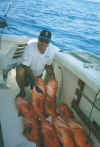 Tight lines, Tight lines,
Ted Cernak
|